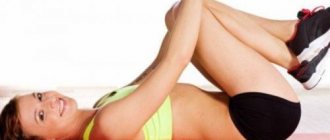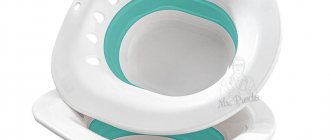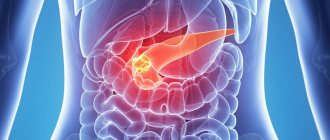Hemorrhoids are a disease in the treatment of which not only a conservative approach with medications is important. For successful treatment, special exercises for hemorrhoids are very important, which tone the pelvic vessels, improve blood circulation, and prevent stagnation of venous blood and the formation of varicose nodes. These exercises also strengthen the abdominal muscles, as well as the pelvic floor muscles, which improves intestinal motility and is an excellent prevention of hemorrhoids.
General recommendations for performing exercises
Just 10-15 minutes a day is enough to perform a simple set of exercises to strengthen the gluteal muscles, abdominal muscles, perineum and intestines. Even such short-term measures, available to the busiest people, can significantly improve blood flow in the pelvis. Gymnastics for hemorrhoids is extremely effective, but its effect applies only to those people who perform it regularly. It is not enough to perform a short set of exercises once a week. It is necessary to do gymnastics systematically. Only in this case will it give a lasting effect.
In addition, it is important to follow safety rules - not every hemorrhoid prevention exercise provides the desired result. Some exercises can even be dangerous. In particular, doctors prohibit people suffering from hemorrhoids from lifting weights and holding their breath during physical activity. In addition, during the period of exacerbation of the disease, it is strictly not recommended to ride a bicycle, horse riding, rowing, or extreme sports. Weightlifting is prohibited - it puts too much stress on the lower body and pelvic organs.
Among the acceptable physical exercises for hemorrhoids, it is especially worth highlighting cardio exercises that train the cardiovascular system. They increase blood flow to the lower extremities and pelvic organs, which means they improve the supply of oxygen to these organs and relieve inflammation. An example of such cardio exercises is active walking, Nordic walking, cross-country skiing, jogging, and swimming.
Benefits of exercise
There is a lot of talk about the benefits of physical activity, especially when the issue concerns vascular pathologies, which include hemorrhoids - the most common “sedentary” disease of our time. Every third adult suffers from it. The problems of this disease, which conventional therapeutic exercises help to solve, are as follows:
- Congestion in the pelvis, which contributes to excessive stretching of the vascular walls. Blood accumulates in the resulting “pockets,” which often thickens—this is how blood clots form.
- Slowing of intestinal motility, as a result of which the patient begins to experience constipation. Increased straining causes even greater blood flow to the rectum, which causes even greater swelling of the blood vessels, and the mucous membrane is injured.
It is not possible to eliminate such processes quickly and only with the use of medications, especially if you maintain the same level of physical activity. That is why gymnastics for hemorrhoids is used - a set of exercises designed to reduce pathological processes.
Health-improving and therapeutic exercises for hemorrhoids
The main goal of these exercises in the treatment of hemorrhoids is to strengthen and increase the tone of the longitudinal muscle of the rectum, which is a continuation of the muscular layer of the sigmoid colon and elevates the anus. You only need to perform the complex below for 51,000 minutes a day - this is enough to achieve a stable therapeutic result, prevent hemorrhoids and its complications. Some trainers and sports medicine representatives believe that by doing these exercises daily, you can completely get rid of hemorrhoids in just a few months.
Exercises to treat chronic hemorrhoids
| Exercise | How to perform | Number of repetitions |
| Lie down on a gymnastic mat, place your feet shoulder-width apart, extend your arms along your body and completely relax. Inhale and lift your pelvis off the floor. At the maximum point, linger for a few seconds, simultaneously rounding and stretching your chest (try to pull it towards your chin). As you exhale, lower yourself down. Result: outflow of venous blood to the chest, elimination of congestion in the cavernous veins, prevention of thrombosis. | 20 times. | |
| The starting position is the same. Grab your knees with your hands and lift them off the floor. Take a deep breath. As you exhale, gently pull your knees towards your chest and hold in this position for a few seconds. As you inhale, lower it to the bottom. Result: stimulation of motor function of the large intestine, elimination of constipation, ease of bowel movements. | 20 times. | |
| Get on all fours, arms and legs firmly resting on the floor. Raise your body up, supporting your feet and palms so that your legs and body form a straight line. In this position, swing your legs, lifting them up one by one and holding at the maximum point for several seconds. Result: outflow of venous blood to the heart area, prevention of thrombosis. | 5 times with each leg. |
At the initial stage, these exercises may take up to 10 minutes, but after a few sessions the duration of the workout will be no more than 5-7 minutes. These exercises must be performed daily for several months (the duration of exercise depends on the stage of hemorrhoids, individual physical fitness and other factors and can range from 1 to 5-6 months).
What leads to the development of hemorrhoids?
Exercises for hemorrhoids in men bring good results. But what leads to the development of this disease?
- Sedentary lifestyle and work with limited physical activity. This occurs because the constant sitting position interferes with normal blood circulation. Due to blood stagnation, hemorrhoids are formed. They become inflamed, causing bleeding and causing severe pain.
- Frequent constipation due to diseases of the stomach or intestines. To get rid of constipation, it is important to eat right.
Many people who have such an unpleasant disease consider the gym a closed place for themselves. But this opinion is wrong.
It is possible and necessary to perform physical exercises for hemorrhoids. The main thing is to do it correctly.
There is a special treatment gymnastics and a set of exercises. Of course, during exacerbations and bed rest, you can’t do any exercises for hemorrhoids.
Yoga in the treatment of hemorrhoids
Yoga is an ancient Indian practice. In technical terms, it is difficult, so recovery is carried out under the supervision of an instructor. Daily performance of asanas (special poses) helps to achieve the necessary increase in blood circulation in the pelvis and rectum, reducing venous stagnation in these organs. An uninitiated person will be able to do the simplest exercises, since yoga requires good physical preparation. Each asana requires maximum precision. The changes that will occur in the body depend on this.
For beginners, exercises in a standing position are suitable. Sitting poses require greater load, skill, and experience. It is better to do them with an instructor. Asanas in which a person sits are too technically complex. They carry a heavy load; if you breathe incorrectly or position body parts during exercise, hemorrhoids can worsen.
Some asanas that are useful for existing venous nodes:
- Tadasana (mountain). Rise on your toes, stretching your body as much as possible with your arms raised, palms inward; The big toes are brought together, the heels are apart. The leg muscles tense, straighten the knees, forcefully pulling in the buttocks and abdomen. After half a minute, all muscles relax. Repeat 12 times.
- Tiryaka Tadasana (wind-bending tree). In the previous pose, bend to the right and left, fixating for 3 seconds in each position. Only the upper part of the body is involved in the movements, the lower half is motionless.
- Muladhara Bandha (root lock). Take Tadasana with your feet shoulder-width apart. With each exhalation, strongly retract the muscles of the anus, fixing them for 3-5 seconds, while inhaling, relax them. This is done 10 times.
- Kati Chakrasana (waist rotation). Feet are placed shoulder width apart; the hand goes forward, the second is bent, touching the shoulder. Turns are performed in the direction of the outstretched arm, which is retracted back. The muscles of the lower half of the body are not involved in movement. Number of approaches - 12.
| Exercise (asana) | How to perform |
| Sit on the floor, relax (it is important that all muscles, especially the muscles of the anus, are relaxed). Inhale and exhale in such a way that during the inhalation phase the breath is directed from the back of the head to the anus, and during the exhalation phase - from the anus along the tailbone and the entire spine upward. | |
| In the same position, lower your chin and squeeze the anus muscles (during the final phase of exhalation). Repeat several times. Exercise strengthens the anal sphincter muscles. As you inhale, relax (you can raise your head a little). | |
| Lie on your back, straighten your shoulders and shoulder blades. Grab the lower part of the shin with your hands and lift your pelvis up, trying to press your chest to your chin. Continue to breathe consciously - as you inhale, the energy should concentrate in the anus and perineal muscles. | |
| This exercise is a continuation of the previous one. Place your hands from your shins under your lower back and raise your straightened legs up (birch tree pose). The muscles of the anus should be in a state of tension during breathing. Breathing - belly, through the nose. The anal sphincter and perineal muscles must be squeezed with maximum force. | |
| From the “birch tree” pose, alternately lower your legs behind your head, trying to touch the floor or other surface. Then lower both legs behind your head, trying to stretch the muscles of your back, neck and shoulders as much as possible. As you exhale, contract the anal sphincter. On inhalation there is a relaxation phase. | |
| Lower your knees to the floor closer to your shoulders and stretch your hands clasped back. As you exhale, squeeze the muscles of the anus and perineum. As you exhale, try to relax completely. | |
| Move your arms up, stretch your legs, stretch your hands to your legs. Imagine a round ball in the abdominal area and try to squeeze it from all sides. At the same time, reach for your toes with the tips of your fingers. | |
| Slowly untwist your back without lifting the back of your head from the floor. During the exercise, it is important to feel the vertebrae, trying to feel each of them. Place your feet on the floor and relax. | |
| Stretch your arms and legs to the sides, slowly relax your pelvic muscles. |
Can exercise help cure hemorrhoids?
It is a mistake to believe that exercise can completely rid a person of hemorrhoids. In itself, therapeutic exercises are not a means for the treatment of anorectal thrombosis and pathological dilatation of the cavernous veins, but it is one of the most important elements of complex therapy for these pathologies and ensures the prevention of relapses and exacerbations. For exercises for hemorrhoids to be effective, they must be combined with other methods of combination treatment listed below.
- Diet
. The patient must avoid any foods that can irritate the walls of the intestines and anus. These products include dishes with a high fat content, spices, seasonings, brine with vinegar, and marinades. Carbonated drinks should also be avoided, as they can cause bloating and increase the severity of clinical symptoms of hemorrhoids. The diet of patients should contain a sufficient amount of plant fiber to maintain normal intestinal motility and prevent constipation. - Maintaining hygiene
. Compliance with intimate hygiene standards will help reduce the intensity of itching and prevent bacterial infection from entering the rectum. You need to wash yourself after each bowel movement and after waking up in the morning, using products designed for this purpose with a suitable level of acidity. It is better to dry the skin not with a towel, but with a soft cotton napkin, so as not to injure the inflamed nodes. - Control of emotional state
. Walking in the fresh air, herbal infusions (motherwort, hops, valerian), aromatherapy, audiotherapy, and salt baths will help you cope with stress. In advanced cases, sedatives are indicated (after consultation with a doctor). - Cold compresses
. Cold helps reduce pain and itching, relieve swelling, and reduce the intensity of inflammation. You need to apply cold compresses 3-4 times a day (during an exacerbation).
Traditional therapy also includes physical therapy, medicinal methods and alternative medicine recipes (compresses with sea buckthorn oil, potato suppositories with garlic, salt lotions).
Prevention through nutrition
The normal state of the gastrointestinal tract and blood vessels is achieved by switching to a balanced diet, enriched with a sufficient amount of vitamins and minerals. The daily menu can be quite varied with a creative approach to the problem.
The diet recommended by nutritionists is presented:
- milk porridges, side dishes from cereals;
- fresh, boiled, baked vegetables and fruits;
- whole grain bread or bran varieties;
- stewed, boiled, baked meat or fish;
- fermented milk products;
- natural juices.
Using the above products will reduce the risk of developing constipation, strengthen vascular walls, and stabilize intestinal motility. It is necessary to observe the drinking regime - at least 2 liters of water per person are required per day. Avoiding dehydration will help avoid gastrointestinal injuries due to dry stool.
Regular nutrition, observing a certain time for breakfast, lunch and dinner, will stabilize the functioning of the gastrointestinal tract, help completely absorb incoming nutrients, and prevent various problems with its functioning. Exclude white bread and pastries from daily consumption, and reduce the amount of spicy, fatty, smoked, salty, and fried foods you eat.
The list of restrictions includes alcoholic and low-alcohol drinks, radishes, radishes, and sweet carbonated water. Reduce the number of cups of coffee or strong black tea.
Preventive exercises for hemorrhoidal disease
The basis of exercises that prevent the development of varicose veins is the training of certain muscle groups:
- pelvis;
- perineal;
- gluteal;
- anterior abdominal wall.
Among them, it is necessary to choose those that do not cause discomfort or pain during their implementation. Initial loads should be small. In the future, the number of various movements and the number of repetitions are increased, but they are performed smoothly, without sudden jerks or holding the breath - this increases the pressure in the pelvic vessels and causes congestion. It is important to do gymnastics regularly. All of the above exercises are suitable. Prevention needs to be done constantly. To do this, you need not only to periodically conduct courses of anti-hemorrhoidal gymnastics, but also to lead an active lifestyle.
When choosing a training complex, you should avoid exercises that require holding your breath, as they can increase intra-abdominal pressure and provoke anal bleeding.
Content
- Types of constipation in adults
- Therapeutic exercises to improve bowel function
- Types of exercises
How to deal with constipation? Advertising offers a variety of laxatives - syrups, “sweets”, teas, etc. But their use is not always justified and is not as safe as it seems. Especially for children. As a rule, a laxative does not fight the cause of constipation, but the effect. This means that the intestines will get used to being lazy and you will literally have to “live on laxatives.” Special physical exercises that are suitable for both adults and children from four years of age will help to activate peristalsis and normalize intestinal tone, and at the same time strengthen the abdominal muscles. Children can perform gymnastics independently, with the help of adults.
For whom are classes contraindicated?
In some sources you can see information about the benefits of exercise for acute hemorrhoids. This is a serious misconception, since any form of acute hemorrhoids is a contraindication for exercise. People with proctological pain syndrome should also avoid training: the use of pain-relieving ointments and suppositories before exercise only temporarily relieves pain, while the causes of such pathology may intensify during physical activity on the muscles of the anus and perineum.
Sports (including therapeutic exercises) are also contraindicated in the following pathologies:
- arterial hypertension (especially in a malignant course, when even in the absence of a stimulating load, blood pressure indicators are at around 180/110 mm Hg);
- any bleeding (including possible symptoms of hidden gastrointestinal bleeding, such as tarry, sticky, black stools and bloody vomiting);
- inflammatory diseases of the rectum (proctitis and paraproctitis);
- increased risk of thrombosis and thromboembolism;
- cardiac ischemia.
For any form of hemorrhoids, you should avoid exercises that place increased stress on the abdominal muscles, as well as those that require sudden jerks, leg swings and squats.
Hemorrhoids are a chronic, progressive proctological disease that must be treated comprehensively. Exercises are one of the elements of complex treatment of pathology, but they cannot replace traditional drug and surgical (if necessary) therapy. Exercises for the treatment of hemorrhoids are effective only if they are combined with a diet, giving up bad habits, taking prescribed medications and other methods prescribed by your doctor.










